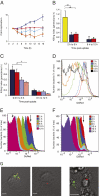Dynamics of intracellular bacterial replication at the single cell level
- PMID: 20133586
- PMCID: PMC2840444
- DOI: 10.1073/pnas.1000041107
Dynamics of intracellular bacterial replication at the single cell level
Abstract
Several important pathogens cause disease by surviving and replicating within host cells. Bacterial proliferation is the product of both replication and killing undergone by the population. However, these processes are difficult to distinguish, and are usually assessed together by determination of net bacterial load. In addition, measurement of net load does not reveal heterogeneity within pathogen populations. This is particularly important in persistent infections in which slow or nongrowing bacteria are thought to have a major impact. Here we report the development of a reporter system based on fluorescence dilution that enables direct quantification of the replication dynamics of Salmonella enterica serovar Typhimurium (S. Typhimurium) in murine macrophages at both the population and single-cell level. We used this technique to demonstrate that a major S. Typhimurium virulence determinant, the Salmonella pathogenicity island 2 type III secretion system, is required for bacterial replication but does not have a major influence on resistance to killing. Furthermore, we found that, upon entry into macrophages, many bacteria do not replicate, but appear to enter a dormant-like state. These could represent an important reservoir of persistent bacteria. The approach could be extended to other pathogens to study the contribution of virulence and host resistance factors to replication and killing, and to identify and characterize nonreplicating bacteria associated with chronic or latent infections.
Conflict of interest statement
The authors declare no conflict of interest.
Figures




Similar articles
-
Identification of salmonella pathogenicity island-2 type III secretion system effectors involved in intramacrophage replication of S. enterica serovar typhimurium: implications for rational vaccine design.mBio. 2013 Apr 16;4(2):e00065. doi: 10.1128/mBio.00065-13. mBio. 2013. PMID: 23592259 Free PMC article.
-
A comprehensive study of the contribution of Salmonella enterica serovar Typhimurium SPI2 effectors to bacterial colonization, survival, and replication in typhoid fever, macrophage, and epithelial cell infection models.Virulence. 2011 May-Jun;2(3):208-16. doi: 10.4161/viru.2.3.15894. Epub 2011 May 1. Virulence. 2011. PMID: 21540636 Free PMC article.
-
SseL is a salmonella-specific translocated effector integrated into the SsrB-controlled salmonella pathogenicity island 2 type III secretion system.Infect Immun. 2007 Feb;75(2):574-80. doi: 10.1128/IAI.00985-06. Epub 2006 Dec 11. Infect Immun. 2007. PMID: 17158898 Free PMC article.
-
Salmonella enterica replication in hemophagocytic macrophages requires two type three secretion systems.Infect Immun. 2010 Aug;78(8):3369-77. doi: 10.1128/IAI.00292-10. Epub 2010 Jun 1. Infect Immun. 2010. PMID: 20515933 Free PMC article.
-
SoxS is a positive regulator of key pathogenesis genes and promotes intracellular replication and virulence of Salmonella Typhimurium.Microb Pathog. 2020 Feb;139:103925. doi: 10.1016/j.micpath.2019.103925. Epub 2019 Dec 12. Microb Pathog. 2020. PMID: 31838175
Cited by
-
Frequency of antibiotic application drives rapid evolutionary adaptation of Escherichia coli persistence.Nat Microbiol. 2016 Mar 7;1:16020. doi: 10.1038/nmicrobiol.2016.20. Nat Microbiol. 2016. PMID: 27572640
-
Bacterial recognition pathways that lead to inflammasome activation.Immunol Rev. 2015 May;265(1):112-29. doi: 10.1111/imr.12289. Immunol Rev. 2015. PMID: 25879288 Free PMC article. Review.
-
Persistent Infection and Long-Term Carriage of Typhoidal and Nontyphoidal Salmonellae.Clin Microbiol Rev. 2018 Nov 28;32(1):e00088-18. doi: 10.1128/CMR.00088-18. Print 2019 Jan. Clin Microbiol Rev. 2018. PMID: 30487167 Free PMC article. Review.
-
Cyclic-di-GMP regulation promotes survival of a slow-replicating subpopulation of intracellular Salmonella Typhimurium.Proc Natl Acad Sci U S A. 2019 Mar 26;116(13):6335-6340. doi: 10.1073/pnas.1901051116. Epub 2019 Mar 12. Proc Natl Acad Sci U S A. 2019. PMID: 30862737 Free PMC article.
-
Cytoplasmic Mg2+ supersedes carbon source preference to dictate Salmonella metabolism.Proc Natl Acad Sci U S A. 2025 Apr;122(13):e2424337122. doi: 10.1073/pnas.2424337122. Epub 2025 Mar 25. Proc Natl Acad Sci U S A. 2025. PMID: 40131949
References
Publication types
MeSH terms
Grants and funding
LinkOut - more resources
Full Text Sources
Other Literature Sources
Molecular Biology Databases
Research Materials

